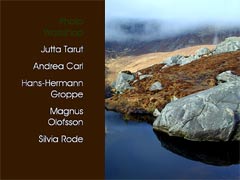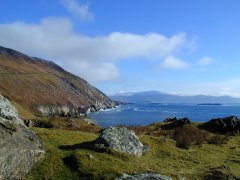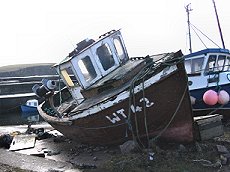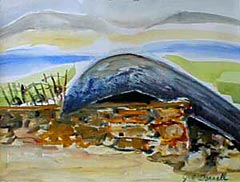WANTED
The Person with the loveliest smile!

We admire him all for his lovely smile
And all came to see it for many a mile
You can help us to find him
By standing around him
And win something nice from the Isle
Contact his secret friend for reward
Europe goes to school
This afternoon we visited the SCOIL DAMHNAIT SCHOOL in Achill Sound. It's a secondary school with 120 pupils. They start to go there at the age of 12 (first class) and they finish school at the age of 17 or 18 years (fifth class), then they will have to pass their final exam, which is called "Leaving Search" (A-Level). The school has an entry, that covers 15 to 20 miles and the young people are mostly coming with the bus at 9.20 and they leave at 4 p.m.
They have the opportunity to choose between learning French or Latin, and every pupil has to learn Gaelic. Four years ago the school-uniform has become obligatory. So the momentary fifth class is the only and last class that is allowed to wear their own clothes to school. But surprisingly, most pupils liked to wear school-uniforms. "You don't have to get up earlier in order to think about what to wear to school today!" was the most common answer to our question.
 All
pupils were very nice polite. A special thanks to the senior class!
All
pupils were very nice polite. A special thanks to the senior class!The answer to the question what they think of first when they hear "German" was Hitler in the first place and Volkswagen in the second. Maybe with our visit we could contribute to the fact that foreigners don't think of our bad history first but of the nice things they know about the country and of the people they actually know.
With Columbia they connected the soccer team.
When the pupils finish school at 4 p.m. they have to do their homework and in their rare free-time they like to do things like sports, making music, dancing. At the weekends they like to go out in pubs, nightclubs and cinemas. Some pupils are also going to the IT-Center to learn more about modern, virtual communication and the information technologies.
When asked whether they like to live on Achill Island, some of them said no, but most of them said they like to live here because they know each other and when they go out you are able to go home alone without feeling frightened but feeling safe. If I compare the Irish teenagers to the German ones, there are many similarities in their wishes and feelings. I was a little bit shocked when a boy asked us if we thought that the Achill people are backward. They are as backward as all other European countries: not at all. The difference to Germany for example is that we don't have traditions like the Irish music. Just because the Irish have a traditional awareness it doesn't mean they are backward. I like the Irish very much. They are an extraordinarily friendly people with an admirable attitude towards foreigners.
Christine Greiner
Photo Workshop
 Today
we continued working on our presentation for Friday evening and for the
web. Everyone had a personal "session" with Magnus to put the
stories and poems and the photos together. Sometimes it wasn't so easy to
find the right rhythm, to decide whether to fade out or in or to take short
cuts. Finally we all came to a satisfactory result.
Today
we continued working on our presentation for Friday evening and for the
web. Everyone had a personal "session" with Magnus to put the
stories and poems and the photos together. Sometimes it wasn't so easy to
find the right rhythm, to decide whether to fade out or in or to take short
cuts. Finally we all came to a satisfactory result.Then we worked a while at how we should stand in front of the audience and how to prepare the "show room".
Shared Landscape: Excursion to Keem Bay (08 February 2001)
On Thursday, the weather was better than anyone might have expected at the beginning of the week. The conditions for our excursion were very good so we could explore the roads, the shores and the cliffs that are a part of Achill's culture.
First we went to Lough Accorymore, a deep glacial lake which is the island's principal source of drinking water. Its depth was tested and it was found to be more than 30 metres. Every now and then, there are proposals to create road connections into the mountain landscapes, but, luckily, these plans haven't been realised so far. Another change to the landscape which causes problems is the widespread use of fences in order to keep the sheep away from certain areas.
 Our
next stop was Keem Bay. We walked up to the cliffs, and on the way up
there, we were told about the fishermen in the region. Some of their huts
are still there. In the 1960s and 1970s, the liver of the Basking Shark
was quite an attractive raw material for producing paraffin. The sharks'
fins were also used for seafood specialties.
Our
next stop was Keem Bay. We walked up to the cliffs, and on the way up
there, we were told about the fishermen in the region. Some of their huts
are still there. In the 1960s and 1970s, the liver of the Basking Shark
was quite an attractive raw material for producing paraffin. The sharks'
fins were also used for seafood specialties.  In
those years, around 1000 sharks were fished during one summer. Thomas
could still remember a shark which had been washed up on the beach; it
was 8 metres long and the carcass was wider than one metre. Attacking
the shark would be quite a tough and gruesome activity. The bay would
sometimes be red with blood. The sharks would be surrounded by boats,
trapped in a net and harpooned again and again. The fishing stopped when
the market collapsed.
In
those years, around 1000 sharks were fished during one summer. Thomas
could still remember a shark which had been washed up on the beach; it
was 8 metres long and the carcass was wider than one metre. Attacking
the shark would be quite a tough and gruesome activity. The bay would
sometimes be red with blood. The sharks would be surrounded by boats,
trapped in a net and harpooned again and again. The fishing stopped when
the market collapsed.
But shark fishing wasn't the only thing that made this region famous. One of the English landlords who arrived during the 1850s was Captain Charles Cunningham Boycott. He built a house and employed local people. Whenever economic problems occurred, Boycott didn't show any concern for his tenants. When the rent was due, he insisted on payment or eviction. However, the Land League was set up in 1879 and the tenants asked for their rights. They decided to ostracise him; none of his products were bought, the local farm workers refused to bring his harvest in, even sabotage may have gone on. Boycott got support from the government. Soldiers were brought in to work in Boycott's fields - but they consumed much of what they harvested. And on top of that, there was no market for the produce. Thus Boycott went bankrupt - and he had to return to England. The word "boycott" was adopted in many European languages .
At the Penal Altar rebuilt in the mountain, we found out about the Penal Laws which were valid during the 18th century. In those days, Catholic priests were persecuted - and they said Mass in the open - using very rough stone altars and always watching out for the arrival of redcoat guards. Many priests were hunted down and hanged during those days. There is a rock called "Priest's Rock" which marks the place where a priest made a narrow escape with a desperate jump across a mountain ridge.
Finally we saw a little amethyst mine in the mountains which was accidentally opened when the road was built.
Painting workshop Thursday, 8 February
 The
day begins in the best manner: The sun is shining - luckily ignoring all
the weather forecasts, the sea reflects the mountains like a mirror.
The
day begins in the best manner: The sun is shining - luckily ignoring all
the weather forecasts, the sea reflects the mountains like a mirror.
Tim, our tour guide, shows us the most interesting sides of Achill Island, telling us that the Irish population decreased from 7 to about 3.5 million in 1850 due to a potato disease. Many people left Ireland from the port of Queenstown, to escape the hunger. This same harbour was the last place the famous Titanic called at on its fateful voyage.
In Ireland acutally, it is fashionable to speak Gaelic, and this is supported by the Gaelic TV and radio stations.
What is produced on Achill Island? Fleece and bed lamps, not to forget the turf, a typical Irish smell reaches our nostrils.
Next stop: Achill Outdoor Education Centre, which instructs people in rock climbing, canooing, wind-surfing and other interesting sports activities. They even teach people to become instructors themselves. This institution also has a social side because it gives courses that help prisoners to reintegrate into society.
We see one bird sitting on a cable:
One for sorrow,
two for joy,
three for marriage,
four to die.
We look for the second.
We see a number of identical cottages, called the toblerones like the Swiss chocolate, a really international feeling on this little island in the far West of Europe.
Bruno Sattler
Today, we concentrated on two things: First, our Swedish speaking member Linda corrected our pronunciation of a Swedish a cappella song that we wanted to sing: "Vem kan segla". Second, we created a true "Achill Island National Anthem". How did we do that? We took an African Zulu song ("Siyahamba") and changed the lyrics so that they would mirror our feelings towards Achill Island. Here's what we came up with: Achill Island, you are wonderful. Brian O'Donnell used to say that, too. Achill Island, you are wonderful, and sometimes your skies are even blue - even blue Achill Island, sunny, sunny island, you have captured us with your bright scenery - scenery Achill Island, rainy, rainy island, you have captured us with your great history.
Our Sea - Your Sea
Thursday morning started with nice weather - a lot of sun and pleasant
temperatures outside.We, the participants of the Our Sea/ Your Sea workshop
were waiting for Sheila McHugh to tell us more about how the sea influences
the life of the inhabitants of Achill Island. Sheila McHugh is a teacher
at the local school. She began with a piece of news that all the participants
of the our workshop are invited to a dinner by Sean (the Genious). Then
she told us how her family got attached to the sea -all her four brothers
are fishermen, and one of them even has the largest privately owned fishing
boats in the world. She also covered the problems connected with fishing,
in particular the safety of ships and the polution of the sea.
An extraordinary evening
When our workshop "Our sea- Your sea" were invited for dinner at John O´Shea´s home, a local islander, we didn´t realize that we were about to experience an evening like we´d never experience before. With great hospitality he welcomed us in his beachhouse and showed pictures of the sea and fishing. He also showed us a videotape about sharkhunting on Achill, how they use to fish the baskinshark. After a lovely dinner and various kind of drinks people started to drop in and some of them had brought instruments. there was Mikael with his guitar, Maria with a banjo, Shay with a tin whistle, Dermot with the uileann pipes and Sara with some kind of small accordian, which I unfortunatly can´t remember the name of. I don´t think that they play like a group all the time, but I think that when they do, they call themselves Achill Sound.
They played and sang for us and with us all evening and we got a small taste of the wonderful Irish culture of music and hospitality.
To be honest, I don´t think that I´ve ever met a kind person such as John and his friends ever before.
"I go to sleep with the sound of the sea every night"
-John O´Shea-
Written by Daniel Torrkulla

